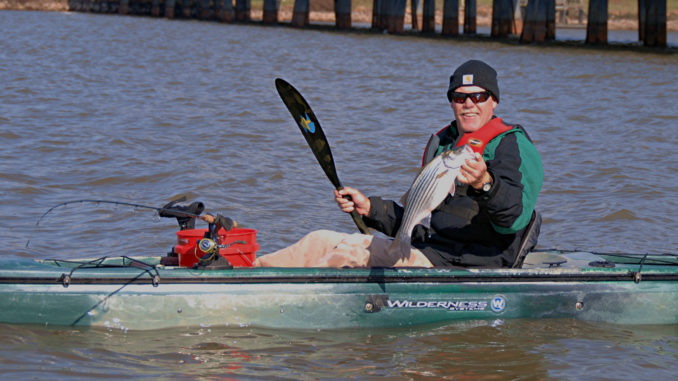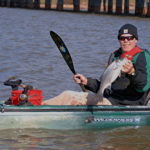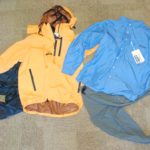
Dress for success, plan a little, paddle all year
Winter is one of the best times to fish anywhere in the Carolinas. The weather is more stable than spring and fall, and angling pressure and boat traffic are lower. Likewise, a number of fish species readily bite all winter.
The biggest drawback is the temperature. Except for the occasional warming trend, it’s cold. However, with state-of-the-art cold-weather apparel and gear, taking the winter off is a big mistake.
Before you load the yak and rods and head for the nearest water to see what’s biting, there are a few things to consider.
Researchers have laid out a proven formula for staying warm by dressing in layers, using specially fitted textiles that remove moisture but retain heat. The first caveat to this is that none of these garments are made with cotton, which acts more as a cooling textile. When wet, it traps moisture around you, so you’re going to have to ditch the jeans and T-shirts.
Hypothermia is a real concern, which is why the US Coast Guard created its 100-degree warning. Add the water temperature and the air temperature; if the sum isn’t at least 100, there’s a serious threat of exposure to hypothermia if you wind up in the water. The Coast Guard also tacks on another 50 equation, stating if you aren’t wearing a life preserver when this happens, there’s a 50/50 chance you won’t make it out of the water.
A base layer of a lightweight, non-restrictive garments is first, typically wool, synthetic materials or silk woven into compression-fitting garments. This layer functions to wick away moisture, leaving dry and warm material next to the skin.
The middle, insulating layer is wool, goose down or fleece, choosing between natural and synthetic materials. The insulating layer can be regulated between lightweight, mid-weight and heavyweight depending on the conditions you’ll be facing.
The outer layer or shell is for weather protection. Even on a bluebird, windless day, the paddling angler is prone to get wet from paddle splash or waves. Waterproof, windproof shells that are breathable — they allow some air circulation to the inner layers — are the best choice.
Again, the weight of outer garments will reflect the severity of the environment, with some added insulation included or merely a shell of polyurethane-coated nylon that is waterproof and windproof.
The clothing list is topped off with head wear and hand wear to keep the paddler both warm and dry. Don’t skimp on these items. Hands, face, feet and head are the first things to get cold. Neoprene (insulated rubber) is a great fabric for covering extremities, especially hands, because of its flexibility. Also in neoprene are glove liners, neck gaiters, and socks.
A note is in order regarding footwear. Once in the boat, there is not much need for heavy tread on the feet, which can also impede those kayakers who pedal versus paddle. However, launching and landing is nearly impossible without your feet getting in the water.
Neoprene footwear, either boots or shoes that are completely waterproof, fit the bill nicely. For deep-water launches or river fishing where getting out of the boat to portage over or around obstacles is likely, a hip boots or chest waders may be in order.
Once properly dressed, add a PFD on top of that clothing. Standard-fill PFDs add bulk, which impedes casting or paddling; inflatable PFDs are a perfect fit for winter paddlers. An auto-inflator is preferred, as a spill in cold water can render you immobile for the first few critical seconds in the water.
Other gear and essentials to prepare for winter outings include a change of dry clothing — a spare base layer and middle layer to change into after a spill — in a waterproof bag. Fortunately, outer shell garments dry quickly when hung up.
Don’t overlook your body’s needs. Your water requirements aren’t much different between a cold, winter day and a hot, summer day. The difference is, physical triggers that tell you more water is needed are not as dramatic when it’s cold.
High energy foods — protein bars and shakes that doesn’t require a lot of room to store — are good to have on board. Your body is being taxed twice, to generate heat and keep warm, while also generating the power to propel you on the water.
Standard gear for winter may not change with regard to the fishing portion of the excursion. A landing net or pair of grips come in handy to land fish without putting your hands in the water. A dry box to store cellphone, keys and camera is particularly handy. Wearing so much clothing, it’s easier to stick those items in a box than go digging through all your pockets.






Be the first to comment